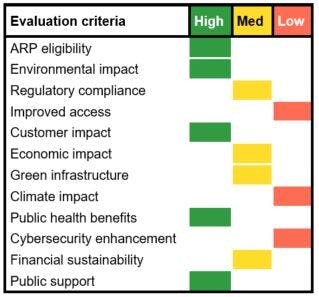
Prioritizing utility infrastructure spending: an analytical approach
The American Society of Civil Engineers, in partnership with the Value of Water Campaign of the US Water Alliance, has estimated that the annual costs of the continuing pattern of underinvestment in the drinking water and wastewater systems in the United States will rise from an estimated $2 billion in 2019 to $14 billion by the year 2039. That is a seven-fold increase over 20 years[1]. The same report concluded that lagging federal investment in the nation’s water infrastructure is placing added pressure on state and local governments to act and that a failure to act could lead to a cumulative gross domestic product decline of $2.9 trillion by 2039 and a $7.7 billion rise in cumulative healthcare costs over the same period.
For virtually all local governments, the costs of replacing and upgrading utility assets demands a significant and continuing investment, often resulting in higher user fees and charges. Historically, many of these essential projects have been financed with long-term debt funding as federal and state grants to help offset the local share of these projects have been limited. Well before the COVID-19 pandemic, water and sewer utilities were facing a number of challenges, including aging infrastructure creating a need for asset renewal and replacement, increased regulatory requirements, the impacts of climate change, a growing emphasis on protecting our environment, limited water supply and others. Interwoven in all of these challenges has been the impact on affordability of utility services resulting from them.
Fortunately, some help may be on the way. Local governments have been allocated $130.2 billion under the provisions of the American Rescue Plan Act (ARP). Eligible uses of these funds include water, sewer and broadband infrastructure, among others. Due to the overall impact on local communities and the myriad economic, health and other quality of life benefits infrastructure improvements can produce, such projects will likely become top contenders as local governments develop their plans for the use of ARP funds.
Municipal leaders should consider the adoption of an inclusive and analytical process for setting infrastructure spending priorities and in determining whether to spend their ARP funds on utility infrastructure or other eligible local needs or opportunities to maximize grant funding. One such technique could be the development of a “heat map” of various evaluative criteria, customized to the policy priorities of each community, as illustrated below. Using a weighted scoring model with defined evaluative criteria and a facilitated ranking process, decision makers can efficiently evaluate the strengths and weaknesses of each infrastructure project under consideration. The heat map reveals the relative strengths and weaknesses of each project, leading to more reliable, repeatable and equitable priority-setting.
The evaluation criteria included in the above example include:
- ARP eligibility – the degree to which the specific project conforms to the federal eligibility guidelines for infrastructure projects
- Environmental impact – the relative positive benefits on the natural environment that the project will produce
- Regulatory compliance – the extent to which the project addresses regulatory imperatives, consent decree requirements, etc.
- Improved access – the degree to which the project improves citizen access to utility services in terms of both availability and cost
- Customer impact – the number of utility customers who will realize a direct and/or indirect benefit from the project
- Economic impact – the significance of the project’s expected impact on the community’s ability to attract, retain and expand its economic base through new businesses
- Green infrastructure – the level of overall contribution of the project to the community’s “green” programs and initiatives
- Climate impact – the relative level of positive contribution to the mitigation of the effects of climate change
- Public health benefit – the degree of public health benefits or the mitigation of public health risks
- Cybersecurity enhancement – the comparative reduction in the risk of security breaches to the utility’s technology systems
- Financial sustainability – the degree to which the project enhances the long-term financial stability of the utility
- Community support – the degree of public support for the project
A well-designed, analytically-supported decision process and strategic plan can help utilities determine how to best apply their ARP funding to help offset the local costs for critical infrastructure investments and help to minimize utility rate increases.
Contact Baker Tilly’s public sector specialists to further explore how your utility can maximize the benefits you realize from the ARP relief funding.
Baker Tilly Municipal Advisors, LLC is a registered municipal advisor and controlled subsidiary of Baker Tilly Advisory Group, LP. Baker Tilly Advisory Group, LP and Baker Tilly US, LLP, trading as Baker Tilly, operate under an alternative practice structure and are members of the global network of Baker Tilly International Ltd., the members of which are separate and independent legal entities. Baker Tilly US, LLP is a licensed CPA firm and provides assurance services to its clients. Baker Tilly Advisory Group, LP and its subsidiary entities provide tax and consulting services to their clients and are not licensed CPA firms. ©2024 Baker Tilly Municipal Advisors, LLC

